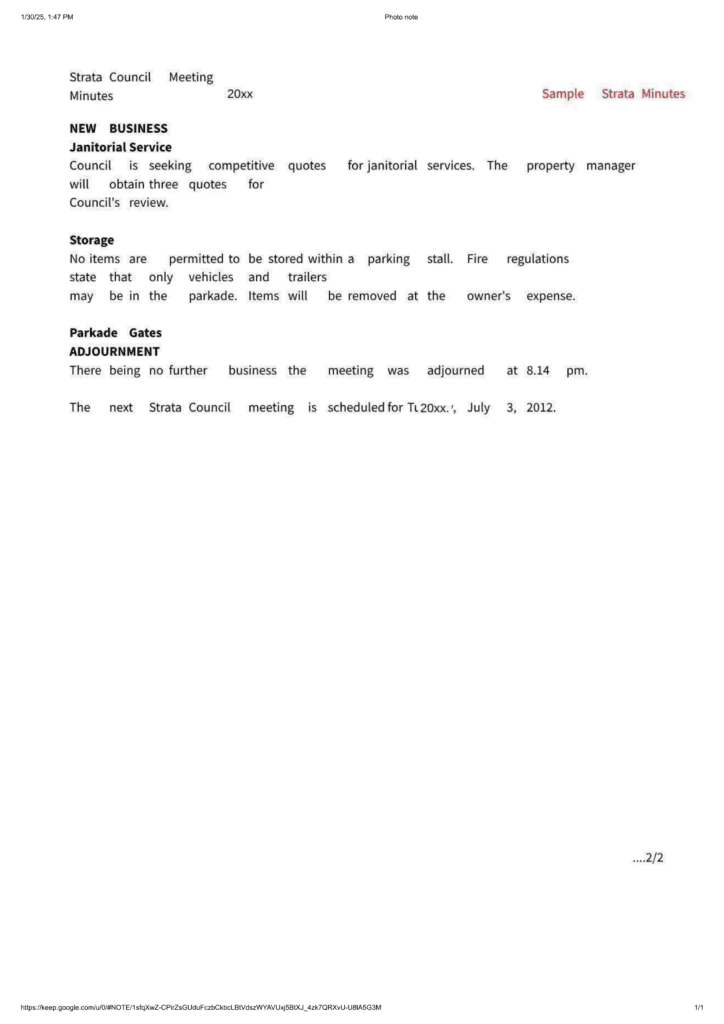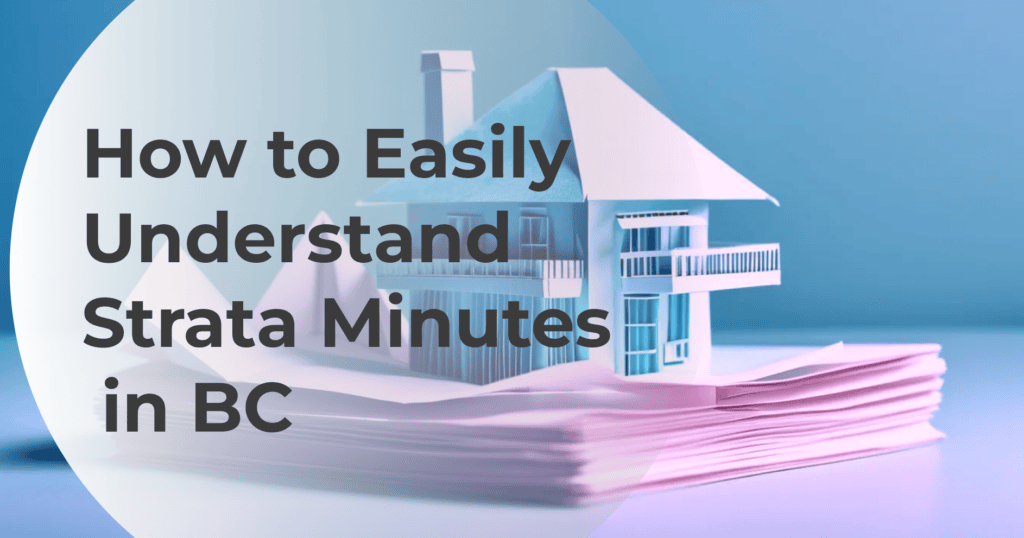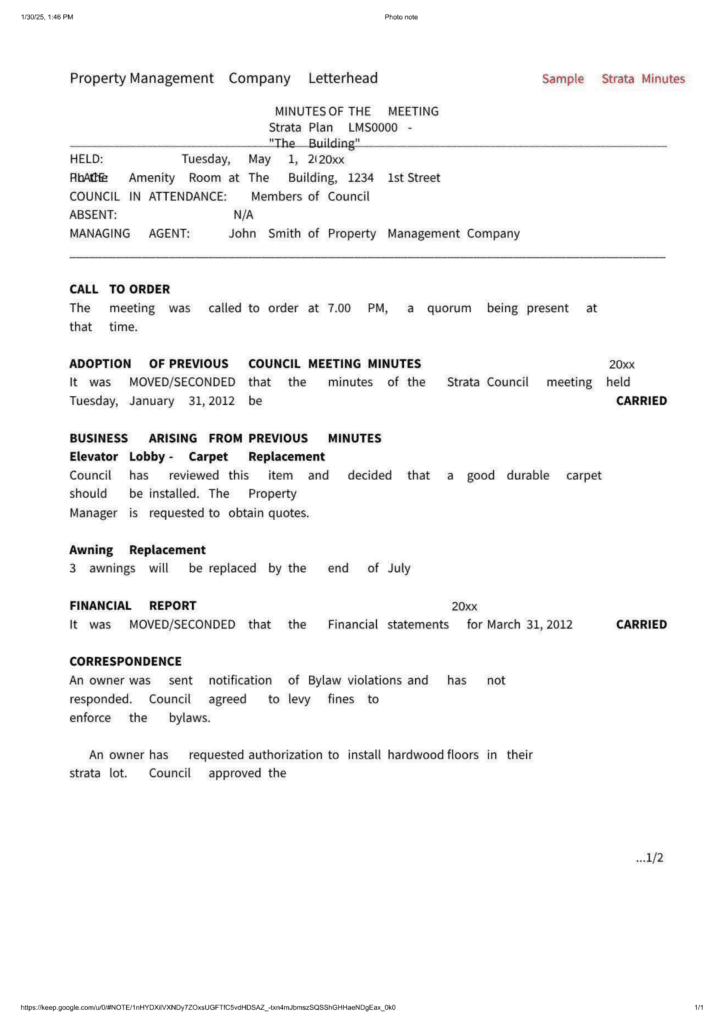Understanding strata meeting minutes is crucial for anyone involved in strata living in British Columbia.
These documents provide valuable insights into the management, decision-making processes, and overall health of a strata corporation.
This article will guide you through the essentials of strata minutes, their importance, and how to interpret them effectively.
Table of Contents
What are Strata Meeting Minutes & Why Are They Important?
Interpreting Strata Meeting Minutes
Who Can Attend a Strata Meeting?
Typical Format & Structure of Strata Minutes
Legal Requirements for Strata Minutes
What are Strata Meeting Minutes & Why Are They Important?
Strata meeting minutes are official records that document the proceedings, discussions, and decisions made during strata council meetings, annual general meetings (AGMs), and special general meetings (SGMs).
They serve as a transparent account of the strata corporation’s business, capturing key information such as:
- Decisions made and who made them;
- Type of meeting held;
- Voting procedures and outcomes;
- Specific directions given by the council.
The Importance of Well-Documented Strata Minutes
Well-documented strata minutes are crucial for several reasons:
- Transparency: They provide a clear record of the strata corporation’s operations, fostering trust between owners and council members.
- Legal compliance: Minutes ensure adherence to the Strata Property Act, which requires strata corporations to keep accurate records of their meetings.
- Historical reference: They allow current owners and potential buyers to review past decisions and assess the effectiveness of previous councils.
- Dispute resolution: In case of disagreements, minutes serve as evidence of what was discussed and decided during meetings.
- Financial planning: Minutes often contain information about budgeting decisions and upcoming expenses, helping owners plan for future costs.
For example, if a strata corporation decides to implement a significant renovation project, the minutes would detail the voting process, budget allocation, and timeline.
This information would be invaluable for current owners planning their finances and for potential buyers assessing the property’s future value.
Recommended Reading: What is the role of strata council?
Interpreting Strata Meeting Minutes
Interpreting strata meeting minutes goes beyond simply reading what was discussed. To truly understand the health and governance of a strata corporation, consider the following detailed strategies:
- Identify Recurring Themes and Issues:
- Look for topics or concerns that appear in multiple meetings, such as repeated mentions of building leaks, elevator repairs, or noise complaints.
- Persistent issues may signal underlying problems that could require significant future investment or indicate ongoing disputes within the community.
- Analyze Financial Health and Planning
- Scrutinize all references to budgets, special levies, contingency reserve funds, and major expenditures.
- Note if the strata is consistently running deficits, approving special levies, or deferring maintenance. These patterns may highlight financial instability or poor planning.
- Check for transparency in how financial decisions are made and documented.
- Evaluate Council Decision-Making and Follow-Through
- Assess whether action items from previous meetings are tracked and completed. Minutes should reference updates on outstanding tasks.
- Consider how the council addresses owner concerns and whether decisions are made collaboratively or dominated by a few individuals.
- Assess Community Engagement
- Minutes often note the number of attendees and level of participation at meetings.
- High owner turnout and active discussion suggest a healthy, engaged community. Low attendance may indicate apathy or dissatisfaction.
- Check for Legal and Bylaw Compliance
- Ensure that all decisions and actions align with the Strata Property Act and the strata’s own bylaws.
- Watch for any mention of bylaw amendments, enforcement actions, or legal disputes.
- Spot Red Flags and Positive Indicators
- Red Flags: Frequent deferral of repairs, repeated special levies, ongoing disputes, or lack of transparency.
- Positive Indicators: Timely completion of action items, clear financial planning, and proactive maintenance.
- Compare Across Multiple Years
- Reviewing several years’ worth of minutes can reveal trends: Is the building’s condition improving? Are past issues resolved or recurring?
- This long-term view is especially valuable for buyers assessing future risks and costs.
As an example, if multiple years of minutes indicate repeated delaying of major repairs, it may be a symptom of council reluctance to spend funds, which may lead to more problematic issues and higher cost in the future.
By examining these factors in detail, owners and potential buyers can form a better image of the operation of the strata and social dynamics of the community and make more informed choices about their investment or participation.
Recommended Reading: Why Should You Review Condo & Strata Documents in BC?
Typical Format & Structure of Strata Minutes
Strata minutes typically follow a standard format, including:
- Header information: Date, time, and location of the meeting.
- Attendance record: List of present council members, owners, and any guests.
- Quorum confirmation: Statement that the required number of members were present.
- Approval of previous minutes: Noting that the last meeting’s minutes were reviewed and accepted.
- Financial review: Confirmation that recent financial statements were examined.
- Action items: Details of tasks assigned, responsible parties, and deadlines.
- Voting results: Outcomes of any votes taken during the meeting.
- Next meeting: Date and time of the upcoming council meeting.
- Adjournment time: When the meeting concluded.
Sample Meeting Minutes

Using Tools to Review Minutes in Minutes
Modern technology, such as Eli Report, has revolutionized the way strata documents are reviewed. Here’s how Eli Report adds depth and efficiency to the process:
What is Eli Report?
Eli Report is an AI-powered platform designed to analyze strata documents—including meeting minutes, bylaws, budgets, engineering reports, and insurance policies—quickly and accurately.
Key Features of Eli Report
- Automated Document Analysis: Eli Report processes large volumes of strata documents in minutes, extracting critical information and summarizing key points.
- Issue Detection: The tool flags recurring problems, such as repeated mentions of water ingress, elevator breakdowns, or insurance claims, that might otherwise be buried in lengthy minutes.
- Financial Insights: Eli Report highlights financial decisions, special levies, and budget variances, providing clear indicators of financial health and future obligations.
- Compliance Checks: It checks for compliance with legal requirements and strata bylaws, alerting users to potential governance or procedural concerns.
- Action Item Tracking: The system identifies action items and tracks their completion status across multiple meetings, revealing how effectively the council follows through.
- Benchmarking and Comparisons: Eli Report compares the strata’s financials and maintenance records to similar buildings, helping users understand how their strata measures up.
- User-Friendly Summaries: It generates concise, easy-to-read summaries and visual dashboards, making complex information accessible to all owners and buyers.
How Eli Report Benefits Users
| Saves Time What could take hours or days to review manually is distilled into a comprehensive report within minutes. | Reduces Risk By highlighting hidden issues and financial red flags, Eli Report helps buyers and owners make informed decisions and avoid costly surprises. | |
| Supports Realtors and Professionals Real estate agents use Eli Report to provide clients with clear, actionable insights, fulfilling their duty of care and reducing liability. | Empowers Owners and Buyers Even those unfamiliar with strata governance can confidently interpret the health and management of a building. |
Example Use Case
A potential buyer uploads three years of strata documents to Eli Report. Within minutes, the platform provides:
- A summary of all major repairs discussed and completed,
- A list of repeated issues (e.g., ongoing roof leaks),
- Financial trends, including special levies and reserve fund status,
- A comparison to similar buildings in the area.
This empowers the buyer to ask informed questions, negotiate more effectively, and make a confident purchase decision.
By expanding your approach to interpreting strata minutes and leveraging advanced tools like Eli Report, you can gain a much deeper understanding of a strata corporation’s true condition, governance quality, and financial outlook—ensuring you make the best possible decisions as an owner or prospective buyer.
Uncovering hidden stories within strata meeting minutes
Strata minutes often contain hidden stories that reveal the true nature of a strata community. It’s important to analyze the strata meeting minutes to find these stories, which could include:
Community engagement
The level of owner participation in meetings can indicate a healthy, active community or potential apathy.
Financial health
Frequent special levies or budget overruns might suggest poor financial planning or unexpected maintenance issues.
Management style
The way the council handles disputes or implements new policies can reveal their leadership approach.
Future plans
Discussions about upcoming renovations or amenity upgrades can impact property values and living experiences.
For example if a strata consistently tables decisions on major repairs, this could indicate that council is hesitant to spend money. That could potentially lead to more significant issues and costs down the line.
Recommended Reading: Strata vs Condo – What’s the Difference?
Who Can Attend a Strata Meeting?
Understanding who can attend strata meetings is essential for proper interpretation of the minutes. Generally:
- Strata council meetings are open to council members and sometimes to owners as observers.
- AGMs and SGMs are open to all strata lot owners or their proxies.
However, there are some restrictions:
- Observers at council meetings may be asked to leave during discussions about bylaw enforcement, rental restriction exemptions, or matters that could infringe on personal privacy.
- Non-owners, such as tenants, may attend meetings only if permitted by the strata’s bylaws or invited by the council.
Legal Requirements for Strata Minutes
The Strata Property Act in British Columbia sets specific requirements for strata council meetings and minutes. These must be followed and there are certain standards that are set, including:
Frequency
Strata councils must meet at least twice per year, though many meet monthly or bi-monthly.
Availability
Minutes must be made available to owners within two weeks of the meeting.
Content
Minutes should document decisions, including spending approvals and bylaw enforcement actions.
Privacy considerations
Personal information should be limited to what is necessary for an accurate account of decisions, in compliance with the Personal Information Protection Act (PIPA).
For instance, if a bylaw infraction is discussed, the minutes might state, “The council voted to issue a warning letter to Unit 301 regarding noise complaints,” without naming the resident involved.
Final Thoughts
Understanding strata minutes is essential for anyone living in or considering purchasing a strata property in BC.
These documents offer a window into the operational soul of a strata corporation, providing insights into its governance, community dynamics, and future trajectory.
By familiarizing yourself with the structure and content of strata minutes, you can make informed decisions about your current or potential strata property.
For those who find the process daunting, services like Eli Report offer expert analysis to ensure you don’t miss any critical information. Try for free today.

